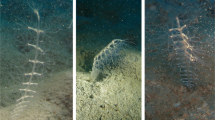Summary
The material, deep sea Anthozoa collected by French research vessels in the Gulf of Biscay in 1972 and 1974 at three permanent stations, contained two delicate species with disc-like body shape, a Corallimorpharian and an Actiniarian. The first species,Nectactis singularis Gravier (1918), is redescribed and the three genera of the family Sideractiidae are discussed with particular reference toSphincteractis Zamponi (1976).
The second species described,Segonzactis platypus n. gen., n. sp., stands out among the Condylanthidae Thenaria because of theEdwardsia- like configuration of its macrosepta.Segonzactis platypus may be considered a transitional form between endomyarian sea anemones with pedal disc and those without pedal disc. According to the classical system of the Actiniaria (Carlgren) it seemed impossible for these taxa to be related.
The two Anthozoans represent a novel morphological adaptation type (Lebensform type) with their disc-shaped bodies presumably floating on the ooze-like surface of the deep sea sediment. The known adaptational types in the Actiniaria are surveyed.
Zusammenfassung
Unter den Tiefsee-Anthozoen, die im Golf von Biskaya in den Jahren 1972 und 1974 an drei Dauerstationen gesammelt wurden, befanden sich auch zwei zarthäutige Arten von scheibenförmiger Gestalt, eine Corallimorpharie und eine Aktinie. Die Redeskription der ersten Art,Nectactis singularis Gravier (1918) schlieβt eine Diskussion der drei in der Familie Sideractiidae zusammengefaβten Gattungen ein, unter besonderer Berücksichtigung der GattungSphincteractis Zamponi (1976).
Die zweite Art istSegonzactis platypus n. gen., n. sp., die sich durch ihreEdwardsia-ähnliche Septen-Konfiguration innerhalb der Thenaria (Familie Condylanthidae) auszeichnet.S. platypus wird als ein Modell des Überganges von endomyaren Aktinien mit Fuβscheibe zu jenen ohne Fuβscheibe angesehen. Eine Beziehung dieser beiden Taxa war nach der klassischen Darstellung des Aktinien-Systems (Carlgren) nicht denkbar.
Die beiden Anthozoen stellen einen neuen Lebensformtyp dar; der scheibenförmige Körper beider Arten verhindert vermutlich das Einsinken in die lockere, halbflüssige Oberfläche des Tiefsee-Sedimentes. Ein Überblick über die bisher bekannten Lebensformen bei Aktinien wird gegeben.
Similar content being viewed by others
Abbreviations
- C:
-
column
- MES :
-
mesogloea
- M.O. :
-
mesogloeal outgrowth
- O.D. :
-
oral disc
- P :
-
parietobasilar muscle
- PH :
-
actinopharynx
- pM :
-
p-mastigophore
- R :
-
retractor muscle
- SC :
-
scapus
- SIPH :
-
siphonoglyph
- Sp :
-
spirocyst
- TENT :
-
tentacle
References
Aldred, R.G., Riemann-Zürneck, K., Thiel, H.: Ecological observations on the deep sea anemoneActinoscyphia aurelia. (In press, 1979)
Carlgren, O.: Zoantharien. Hamburger Magelhaenische Sammelreise4, 1–47 (1899)
Carlgren, O.: Actiniaria der Deutschen Tiefsee-Expedition. Wiss. Ergebn. dt. Tiefsee-Exped. “ Valdivia”22, 126–266 (1928)
Carlgren, O.: Ceriantharia, Zoantharia and Actiniaria. Rep. scient. Results Michael Sars N. Atlant. deep Sea Exped.5, 1–52 (1934)
Carlgren, O.: Actiniaria Part II. Dan. Ingolf-Exped.5 (12), 1–92 (1942)
Carlgren, O.: A survey of the Ptychodactiaria, Corallimorpharia and Actiniaria. K. svenska Vetensk Akad. Handl. (Ser. 4)1, 1–121 (1949)
Doumenc, D.: Actinies bathyales et abyssales de l'océan Atlantique nord Familles des Hormathiidae (genresParacalliactis etPhelliactis) et des Actinostolidae (genresActinoscyphia etSicyonis). Bull. Mus. natn. Hist, nat, Paris, Zoologie197, 157–206 (1975)
Dunn, D.F., Bakus, G.J.: Redescription and ecology ofLiponema brevicornis (Mc Murrich, 1893), with definition of the family Liponematidae (Coelenterata, Actiniaria). Astarte10, 77–85 (1977)
Gravier, G.: Note préliminaire sur les Hexactiniaires etc. (Croissières de la Princesse-Alice et de Hirondelle 1888-1913). Bull. Inst, océanogr. Monaco346, 1–24 (1918)
Gravier, G.: Hexactinides provenant des Campagnes des yachts Hirondelle et Princesse-Alice 1888-1913. Résult. Camp. scient. Prince Albert I63, 1–105 (1922)
Riemann-Zürneck, K.: Actiniaria des Südwestatlantik. IV.Actinostola crassicornis (Hertwig, 1882) mit einer Diskussion verwandter Arten. Veröff. Inst. Meeresforsch. Bremern.17, 65–85 (1978a)
Riemann-Zürneck, K.: Tiefsee-Aktinien der Familie Actinoscyphiidae aus dem Nordatlantik (Actiniaria, Mesomyaria). Zool. Scripta7, 145–153 (1978b)
Schmidt, H.: Die Nesselkapseln der Anthozoen und ihre Bedeutung für die phylogenetische Systematik. Helgoländer wiss. Meeresunters.23, 422–458 (1972)
Schmidt, H.: On evolution in the Anthozoa. Proc. Sec. Int. Coral Reef Symp.I, 533–560 (1974)
Stephenson, T.A.: On certain Actiniaria collected off Ireland by the Irish Fisheries Department during the years 1899–1913. Proc. R. Ir. Acad.34 (B), 106–164 (1918)
Stephenson, T.A.: On the classification of Actiniaria. Part I. Forms with acontia and forms with a mesogloeal sphincter. Q. Jl. microsc. Sci.64, 425–574 (1920)
Stephenson, T.A.: On the classification of Actiniaria. Part III. Definitions connected with the forms dealt with in Part II. Q. Jl. microsc. Sci.66, 247–319 (1922)
Zamponi, M.O.: Emendation to family Sideractiidae Danielssen 1890 (Anthozoa: Corallimorpharia) with the creation ofSphincteractis sanmatiensis gen. et sp. nov. Physis (Secc. A), Buenos Aires35, 127–133 (1976)
Author information
Authors and Affiliations
Additional information
The material analysed in this study has been sorted by the Centre National de Tri d'Océanographie Biologique in Brest, France
Rights and permissions
About this article
Cite this article
Riemann-Zürneck, K. Two disc-shaped deep sea Anthozoa from the Gulf of Biscay, with a survey of adaptation types in the Actiniaria. Zoomorphologie 93, 227–243 (1979). https://doi.org/10.1007/BF00994001
Received:
Issue Date:
DOI: https://doi.org/10.1007/BF00994001




